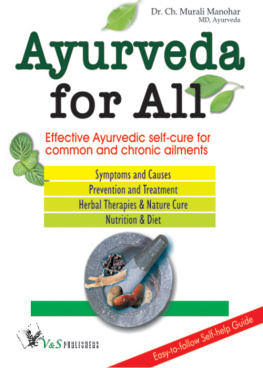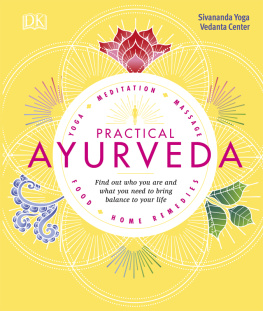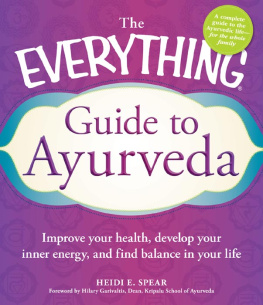


Contents



Introduction
Ayurveda is one of the most ancient systems of healthcare known to man. It was first established at least 5,000 years ago and has been in continual practice ever since. Ayurveda is now recognized as the forefather of all the eastern forms of medicine and perhaps, too, the very roots of western medicine. It is still the most widely used healthcare system in India and is recognized by the World Health Organization as one of the principal healing disciplines.
A yurveda means, literally, science of life: ayu being the Sanskrit word for life and veda for knowledge. As its name suggests, ayurveda is a body of knowledge of wisdom that covers all aspects of our lives and it is holistic in the true sense of the word. Unlike allopathic western medicine, which has traditionally addressed itself to the relief of symptoms, ayurveda not only aims to eradicate the underlying causes of disease, it begins from an altogether deeper level: creating a balance within body and soul that acts as an effective defence against illness.
Prevention rather than cure
In ayurveda, the prevention of disease is even more important than its cure. In the West, we are used to a mechanistic attitude to the body, regarding it as something to be repaired when it breaks down, as we would a piece of machinery. We are used to taking medicine or undergoing surgery to counter a very specific illness or symptom. As a result, some of ayurvedas preventative methods may seem strange at first. As complementary and holistic therapies have become increasingly popular, most of us have become aware that a beneficial diet and exercise are vital for maintaining good health. In addition to these disciplines ayurveda includes those that might initially seem quite unconnected with your health, for example meditation, the way you pace your day, breathing techniques and establishing a different relationship with nature. According to ayurveda, however, just about everything is connected to your state of health. Not only does it see you in a holistic light there are no barriers between body, mind and spirit in ayurveda it sees you as a part of the environment, nature and the universe beyond. For you to be healthy and content, you must be in harmony not just within yourself but with the world around you.
Harmony and balance: these are the starting points of ayurveda and the place to which it always returns. The principle is easy enough to grasp after all, people who are at ease with themselves and those around them are generally happier and less prone to stress than those who are at odds with the world. Ayurveda turns this sense of harmony into a goal that you can move towards, step by step, as you develop an understanding and experience of how the mind and body work and of some basic laws of nature. As you begin to look at life and nature through ayurvedic eyes, you see it in quite a different way. And, though the underlying precepts may seem simple and straightforward, they can revolutionize your health and sense of wellbeing to a profound degree.
Ayurveda in the West
Given the potency of ayurveda then, it may seem strange that it has made little impact in the West. There are a number of reasons for this. Under British rule, western medical practices were introduced in India and many Indians began to regard ayurveda as a second-class form of healthcare at best and, at worst, little more than superstition. Given the low esteem in which it was held by Indians, there was little chance of it becoming more highly regarded away from the land of its birth.
In recent years, however, certain ayurvedic practitioners and teachers (notably the Maharishi, Deepak Chopra, Vasant Lad and David Frawley) have gone back to the original teachings of the rishis (the enlightened sages of the ancient vedic texts). At last, this highly sophisticated and effective system of healthcare has emerged from the shadows of folklore to enjoy a timely revival. However, in the West it has still not caught on in quite the way that might have been expected. The reason for this is that it is still regarded as being part of a very Indian philosophy and way of life. Westerners imagine that ayurveda necessitates changing to an Indian diet, undergoing dire, purgative treatments, adopting at least the lotus position, if not an entire religion and culture. Not surprisingly, this is more of a change than most of us are keen to make.
European ayurveda
None of these radical changes is necessary, how-ever, because ayurveda is universal. And this is where European ayurveda (EAV) the health spas and this book comes in, interpreting this vast body of knowledge for the West. Without diluting its core principles, the aim of EAV is to make the benefits of ayurveda available and accessible to westerners by adapting its precepts to the western way of life. The natural laws that operate in the West are subtly different from those in India its climate, culture and social conditions. For instance, in a system of healthcare in which the rhythms of the seasons play an integral part, we need to look at the climate that exists in the place where we live. Ayurveda traditionally includes the monsoon something that few of us in the West experience.
Similarly, over many generations, our digestive systems have evolved to cope with different kinds of food. The Indian diet includes much more oil and ghee than most westerners could comfortably cope with and it would be unrealistic and not particularly profitable in health terms for us simply to adopt wholesale the diet of the sub-continent. Instead, EAV recommends food from your own environment and culture because you are a part of it, just as it is a part of you.
There is no need, either, to tie our limbs in knots in order to be able to meditate or practise yoga, nor do we have to change our belief system in order to make ayurveda work for us. Ayurveda is, above all, a natural philosophy. And, in our frantically busy and high-tech world, it puts us back in touch both with our own physiology and the rhythms of the world around us.

How to use this book
This book explains ayurveda and the concepts of an ayurvedic health spa and shows how you can incorporate these into your life. This is not a book to put away and display on the shelf it is one you can use every day.

I t does not attempt to treat serious conditions in such cases you should always consult a qualified medical practitioner. However, it can make a profound difference to your health and wellbeing, alleviating long-standing chronic conditions, improving your state of mind, reducing stress and enhancing your immune function and your energy levels.
Next page























